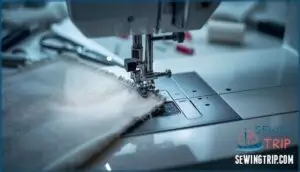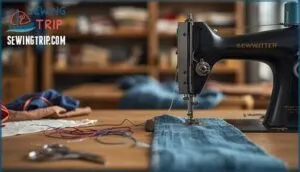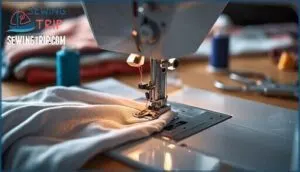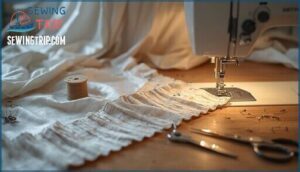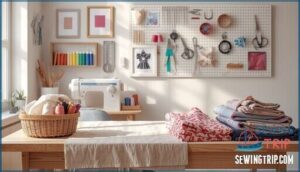This site is supported by our readers. We may earn a commission, at no cost to you, if you purchase through links.
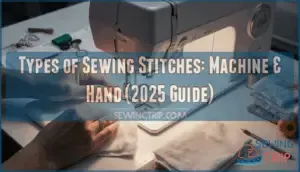
Whether you’re working with delicate silk or heavy denim, the types of sewing stitches you use determine everything from durability to appearance. The good news? Once you understand which stitch does what and why, you’ll stop guessing and start sewing with real confidence.
Your fabric and your project will tell you exactly which stitch belongs, and you’ll have the skill to deliver.
Table Of Contents
Key Takeaways
- Matching your stitch type to fabric weight and project demands—lightweight silks need fine stitches while heavy denim demands stronger reinforced seams—directly determines whether your garment lasts or falls apart.
- Machine stitches deliver speed and consistency (800–1,500 stitches per minute) while hand stitches give you precision control on delicate fabrics where tension matters; choose based on your project’s durability needs and the control you require.
- Stitch density between 8–14 stitches per inch, combined with proper thread selection (polyester boosts strength 30–40%), increases garment durability by up to 45% and prevents puckering, tearing, and premature wear.
- Master just three fundamental stitches—straight stitch for seams, zigzag for edges, and backstitch for durability—and you’ll handle 90% of sewing projects while building confidence to explore specialized techniques as your projects demand them.
Sewing Stitch Types
Stitch classification isn’t just technical jargon—it’s your roadmap to sewing freedom. Understanding sewing techniques across machine and hand methods lets you match the right approach to your fabric selection and project goals. Machine stitches like straight, zigzag, and overlock deliver speed and consistency. Hand sewing stitches—running, backstitch, whip, blanket, and catch—give you precision control. Each type of stitch in sewing fulfills a purpose, whether you’re securing a seam or adding a decorative flourish.
Master the right stitch, and your sewing transforms—stitch selection is your roadmap to matching technique with fabric and turning fragile projects into garments that endure
Thread types and stitch density affect strength and appearance, so knowing your options means better results. Master these types of hand stitches and machine stitches, and you’ll tackle any project with confidence. That’s how you take control of your craft. For beginners, learning about sewing machine stitches is essential to improve their skills.
Machine Stitch Types
Machine stitches give you speed and consistency that hand sewing can’t match. Most sewing machines come loaded with a handful of essential stitches that’ll handle everything from hemming pants to reinforcing seams.
Let’s break down the five machine stitches you’ll use most often.
Straight Stitch
Your sewing machine’s workhorse, the straight stitch, runs in a perfectly linear path with zero side-to-side movement—just evenly spaced needle penetrations that create clean, strong seams. Stitch length control is essential here: set it around 2.5 mm for balanced strength on most fabrics, but drop to 1.5–2 mm for lightweight materials to prevent puckering. Thread tension optimization and fabric tension management work together to keep your seams flat and professional-looking. This foundational machine stitch manages everything from basic construction to topstitching, and mastering it opens up serious seam reinforcement techniques across nearly every sewing project you’ll tackle. Understanding the basics of straight stitch techniques is vital for achieving professional results.
- Woven fabrics only: Straight stitches lack elasticity, so they’ll snap on stretchy materials
- Adjust for weight: Heavier fabrics need longer stitches (3–4 mm) while delicate ones require shorter spacing
- Thread efficiency: Uses less thread than zigzag stitches, making it economical for long seams
- Stitch density analysis matters: Proper spacing prevents fabric distortion while maintaining durability
Zigzag Stitch
When straight seams can’t handle the job, your machine’s zigzag stitch swoops in with side-to-side needle motion that changes everything. Set width between 3–5 mm and length around 1.5–2.5 mm to access serious fabric compatibility—cotton, denim, spandex, and leather all respond beautifully. This powerhouse prevents fraying through edge finishing, stretches with activewear without snapping threads, and delivers up to 30% better load resistance than straight seams.
Master your sewing machine stitches by experimenting with these settings—wider zigzags boost elasticity while tighter spacing builds seam density. The triple variation uses three stitches per swing, perfect when your project demands both flex and strength.
| Zigzag Benefits | Sewing Machine Usage | Stitch Variations |
|---|---|---|
| Prevents edge fraying without a serger | Standard on most machines | Triple zigzag for stretch fabrics |
| Stretches 15–25% without breaking | Adjustable width/length controls | Narrow for decorative borders |
| Reinforces seams under stress | Wide presser foot required | Dense spacing for durability |
| Works on heavy and light materials | Essential for elastic waistbands | Open spacing for flexibility |
| Increases fabric elongation 20–30% | Critical in swimwear production | Programmable patterns available |
Overlock Stitch
Your machine’s zigzag might handle stretch, but overlock stitch takes edge finishing to a whole new level. Overlock machines trim, stitch, and overcast in one pass—stopping fraying while delivering industrial-grade seam durability. Thread consumption runs higher than lockstitch (around 100 meters per shirt), but you’re buying flexibility and strength that stretch fabrics demand.
Here’s what makes overlock stitching unstoppable:
- Stitch density from 7–20 stitches per inch controls seam strength and appearance
- Two- to five-thread configurations match everything from lingerie elastic to high-stress denim
- Industrial applications dominate knitwear production with speeds hitting 7,000 stitches per minute
- Differential feed eliminates puckering while creating decorative rolled hems
Master these sewing machine techniques and you’ll handle knits, activewear, and technical textiles like a pro.
Buttonhole Stitch
Your garment deserves more than just any hole—buttonhole stitch transforms a basic opening into a reinforced, professional closure. This narrow zigzag pattern locks fabric edges against fraying while creating clean bar tacks at each end.
Seventeen variations exist, from keyhole designs for thick shank buttons on coats to tailor’s buttonholes that grip dense wool or tweed. Modern sewing machines automate the process in under 30 seconds, but hand stitches still dominate embroidery and decorative applications.
Match your stitch variation to fabric weight, button diameter, and stress points like cuffs or waistbands for closures that last.
Basting/Gathering Stitch
Think of this stitch as your safety net—basting and gathering stitches hold fabric temporarily before you commit to permanent seams. You’ll set your machine to maximum stitch length (around 4-5 mm) and skip backstitching so removal stays simple.
For gathering, run two or three parallel rows using your longest stitch, then pull the bobbin threads to create ruffles or shirring—perfect for adding controlled fullness to sleeves, skirts, or waistbands.
Hand basting with running stitches works brilliantly on slippery silks or pattern-matched stripes where you need precision before final stitching. Pull out these temporary seams once your project’s secure, leaving zero bulk behind.
Hand Sewing Stitch Types
Hand sewing gives you control when a machine won’t cut it.
These five stitches cover everything from quick repairs to finishing touches that look pro. Master them and you’ll handle any hand-sewing job with confidence.
Running Stitch
Running stitch is the foundation of hand sewing—and once you’ve nailed it, you’ll breeze through everything from quick basting to traditional embroidery. This stitch involves weaving your needle in and out of fabric at consistent intervals, creating a dashed line on both sides. Perfect stitch tension keeps fabric flat without puckering, while your fabric choice and thread selection determine how well it holds.
Here’s what makes running stitch your secret weapon:
- Basting layers together before permanent stitching—you can remove it easily when you’re done
- Creating geometric patterns in Sashiko or Kantha embroidery with continuous lines
- Quilting lightweight fabrics at 8-12 stitches per inch for uniform seams
- Outlining shapes in hand sewing projects where decorative detail matters
Master this basic hand stitch, and you’ll control sewing speed while exploring stitch variations that suit any project.
Backstitch
Backstitch might just be the strongest hand stitch you’ll master. Dating back to the 11th century, this technique combines durability with precision. It overlaps with each pass, creating a seam that resists unraveling—perfect for high-stress areas.
Your thread selection and stitch tension matter most; waxed thread prevents tangling while consistent tension keeps fabric flat. Whether you’re reinforcing seams or adding decorative lines, backstitch gives you control that running stitch can’t match.
| Aspect | Details | Best For |
|---|---|---|
| Strength | Overlapping structure creates lockstitch effect | Pants, sleeves, repairs |
| Thread | 1–6 strands depending on fabric density | Fine to coarse weaves |
| Stitch Length | 2–4mm for ideal hold | Varied fabric weights |
| Tension | Consistent pressure prevents distortion | Professional seams |
| Application | Hand embroidery, structural seams | Decorative & functional work |
Whip Stitch
Want to create seams that won’t quit? The whip stitch is your answer. This hand-sewing workhorse loops thread diagonally around fabric edges, preventing fraying while joining pieces with a flat, flexible finish.
Measuring just 1/8 to 1/4 inch per stitch, the whip stitch excels at edge finishing on felt, cotton, and leather. You’ll master this stitch fast—experienced sewers exceed 2 inches per minute.
Adjust your tension consistently, space stitches evenly (6–12 per inch for durability), and choose thread weight to match your fabric. From toy-making to appliqué work, the whip stitch delivers strength without bulk. It’s adaptable, reliable, and honestly one of the first techniques every serious sewer should own.
Blanket Stitch
The blanket stitch is your edge-finishing powerhouse, born thousands of years ago in ancient Egypt and refined through centuries of textile craft. This hand stitch forms evenly spaced loops along fabric edges—think of it as armor against fraying.
Space stitches 1/8 to 1/6 inch apart depending on fabric thickness. Master the basic blanket stitch, then explore variations: whipped (adding colored thread for texture), closed (connected triangles for quilts), or crossed (lattice patterns).
Whether you’re finishing blankets, securing appliqué, or reinforcing wool garments, this embroidery technique delivers both durability and decorative flair. You’ll control every loop, transforming raw edges into professional results.
Catch Stitch
Now shift your focus to the catch stitch—a breakthrough for hemming that demands precision. This X-shaped hand stitch creates fabric elasticity by crossing diagonal threads, giving your hems stretch and flexibility.
Space stitches 3/8 to 1/2 inch apart for durability. Thread tension matters: maintain even spacing and use a smaller needle to control thread flow. Work left to right with your needle pointing left, keeping your sewing ergonomics solid with shorter thread lengths.
Perfect for knits and wool, this hem finishing technique stays invisible while delivering professional results that machine stitches can’t replicate.
Stitch Application and Project Matching
Now that you’ve mastered hand stitches, it’s time to match them to your project. The stitch you choose determines whether your work holds up or falls apart—literally.
Consider your fabric first. Lightweight materials like chiffon need delicate stitches with short lengths (2.0–2.5 mm) to prevent puckering. Dense fabrics such as denim demand stronger stitches with longer spacing (2.5–3.0 mm). Thread choice matters equally; polyester enhances seam strength by 10–15% on blended fabrics.
Stitch density and seam finishing work together. Reinforced backstitches at seam ends increase endurance by 25%. For visible hems and decorative work, blanket or catch stitches add both function and finesse.
Project planning means deciding upfront: Is this high-wear or decorative? That answer guides everything—from stitch guides to hand sewing projects to your final result.
Practical Tips for Stitch Selection
Picking the right stitch makes all the difference between a project that holds up and one that falls apart. The truth is, there’s no one-size-fits-all answer—it depends on what you’re making, what fabric you’re using, and whether you’re going by hand or machine.
Let’s break down the key factors that’ll help you make smart stitch choices every time.
Stitch Selection Factors
The right stitch makes all the difference. Start by evaluating your fabric—delicate silks need finer stitches with ideal thread tension between 4 and 5, while heavy denim demands stronger seams at higher densities (10–12 stitches per inch). Consider fabric compatibility: woven fabrics thrive with lockstitches for stability, but knits require elastic options like zigzag stitches that stretch without breaking.
Then think about durability. High-stress areas like crotches experience forces exceeding 30 newtons, so reinforce them with safety stitches. Decorative projects allow flexibility, but workwear needs stitch density and thread quality that won’t compromise under tension.
- Match stitch type to fabric weight and intended use—lighter fabrics need finer stitches, heavy garments need reinforced seams.
Machine Vs. Hand Sewing
You’ve got two paths here, and picking the right one depends on what you’re after. Machine sewing dominates—it cranks out 800–1,500 stitches per minute with dual-thread lockstitches that run 30–50% stronger than hand work. You’ll save serious time on big projects and get consistent results every time.
Hand sewing? That’s your move for precision, repairs, and control on delicate fabrics where tension matters. It costs almost nothing to start, but you’re trading sewing speed for finesse. Know your project’s demands before you choose.
Stitch Application & Matching
Matching stitches to fabrics isn’t guesswork—it’s the difference between garments that last and those that fail. Lockstitch excels on tightly woven fabrics, while overlock and coverstitch flex with knits. Seam strength drops 25% when you misalign stitches to fabric properties.
Stitch density matters too: stay between 8–14 stitches per inch to avoid puckering. Thread selection—polyester core-spun especially—boosts abrasion resistance 30–40% in high-friction zones.
Choose your stitching methods thoughtfully, and you’ll optimize garment durability by 20%.
Stitch Mastery Enhances Sewing Skills
Every stitch you master becomes a tool in your arsenal. Stitch precision isn’t just about appearance—consistent stitch length improves seam strength by up to 45%, transforming your projects from fragile to bulletproof. As you develop hand sewing and machine stitches skills, your motor coordination sharpens, enhancing both speed and accuracy by measurable degrees.
Types of stitches matter because they access sewing efficiency across different fabrics and projects. When you understand stitch mastery techniques and matching applications, you prevent puckering, tearing, and premature wear.
Your cognitive development accelerates too—80% of professional sewists credit sustained practice cycles for their proficiency. That’s not coincidence. Each stitch you perfect builds real competence that compounds over time, transforming your craft from hobby into genuine artistry.
Frequently Asked Questions (FAQs)
What are the different types of stitching?
Stitching breaks down into three core categories: machine stitches, hand stitches, and decorative techniques. Machine stitches, like straight and zigzag, dominate garment construction at 10-12 stitches per inch. Hand stitches—running, backstitch, whip—give you precision control. Decorative stitches add flair.
Your stitch choice depends on fabric type, thread selection, and project demands. Master stitch classification, and you’ll gain complete creative freedom.
What are the different sewing stitches on clothes?
Ever wonder why some seams hold up while others fail? Your fabric stretch, garment construction, and thread choices determine everything.
Machine stitches like straight and zigzag handle most clothes—straight stitch builds seams, zigzag finishes edges on stretch fabrics.
Hand stitches like running stitch and backstitch reinforce problem areas. Whipstitch secures appliqués. Chain stitch and crossstitch add decorative flair.
Match your sewing techniques to your fabric’s demands.
How many basic stitch types are there?
There’s no single answer—it depends on who’s classifying. Industry standards recognize 5 to 6 core stitch types, while sewing guides usually teach about 6 basic hand and machine stitches.
What matters isn’t the count; it’s mastering the ones that dominate your projects: the straight stitch, zigzag, running stitch, and backstitch give you control over 90% of sewing work.
What stitches are offered by a sewing machine?
Modern sewing machines range from entry-level models with 20-50 stitches to high-end machines offering over You’ll usually find utility stitches like straight and zigzag, plus stretch capabilities for knits.
Most machines include multiple buttonhole styles, overlock stitches for edge finishing, and decorative options. Speed control lets you dial in precision. What you get depends on your machine’s tier and price point.
What stitches should I use if I’m New to sewing?
You might think mastering stitches takes years, but beginners actually need just three: the straight stitch for seams, the zigzag for edges, and the backstitch for durability.
Master these fundamentals first—they’ll handle 90% of your projects and build the confidence to explore beyond basics.
How many types of stitches can I use for hand stitching?
You’ve got over 50 documented hand stitches to work with, but don’t let that overwhelm you. Most sewers master about 6 to 8 essential stitches first—running stitch, backstitch, whip stitch, blanket stitch, slip stitch, and French knot.
These cover seams, finishing, and basic embroidery. The rest? They’re specialized tools you’ll pick up as projects demand them.
Start with the fundamentals, then expand your hand stitching toolkit based on what you’re actually making.
How do I choose the right stitch for a specific fabric or project?
Choosing the right stitch demands analyzing your fabric’s weight, stretch, and durability needs. Delicate silks need fine, low-tension stitches to prevent distortion. Heavy denim thrives with reinforced straight stitches at higher tension. Knits require stretch stitches to prevent puckering.
Match your stitch to the project’s wear demands—decorative pieces tolerate delicate stitches, while garments that endure heavy use benefit from lockstitches or backstitches.
Are there any special techniques or considerations for sewing stretchy fabrics?
Stretchy fabrics demand stitches as flexible as they are—think of them as elastic partnerships between needle and thread. Use zigzag or stretch stitches that bend with your fabric instead of fighting it. Ballpoint or stretch needles glide between fibers without snagging; pair them with polyester or woolly nylon threads that won’t snap under tension.
Lower your presser foot pressure, test stitch length around 5–3mm, and stabilize fabric with pins or temporary adhesive to prevent puckering. A walking foot evens out feed and kills distortion.
The secret? Your fabric handling matters as much as your machine settings—move deliberately, never force, and always test on scraps first.
How do you prevent thread tangling during hand sewing?
Use thread about 18 inches long to reduce tangling by up to 70%. Pick needles with larger eyes to decrease friction. Apply beeswax or thread conditioner for 50% fewer tangles. Maintain consistent tension throughout your hand stitching.
These thread management and needle selection strategies eliminate most tangling problems.
Whats the difference between needle sizes and types?
Needle sizes range from fine (70/10) to heavy (120/19), using European and US systems—smaller numbers mean delicate fabrics, larger ones handle thick materials.
Needle types vary by point shape: universal needles work on most fabrics, ballpoint needles glide through knits, sharp needles pierce delicate silk, and denim needles power through heavy fabric thickness.
Matching needle size and type to your fabric prevents thread tension problems, reduces skipped stitches, and maximizes sewing machine performance with proper stitch density.
Conclusion
Master the right stitch, and your sewing transforms from uncertain to unshakeable. Every seam you create tells a story—whether it holds strong or unravels depends entirely on the types of sewing stitches you’ve chosen.
Now that you understand which stitch fulfills which purpose, you’re no longer following patterns blindly. You’re making deliberate choices, controlling outcomes, and building garments that endure. That’s the real power here.
- https://en.wikipedia.org/wiki/List_of_sewing_stitches
- https://textilelearner.net/different-types-of-stitches-uses-in-garments/
- https://www.tlr-journal.com/wp-content/uploads/2022/02/TLR_2021_34_ISLAM.pdf
- https://medcraveonline.com/JTEFT/influence-of-different-sewing-parameters-on-seam-quality.html
- https://www.coats.com/en/info-hub/thread-consumption-guide/

